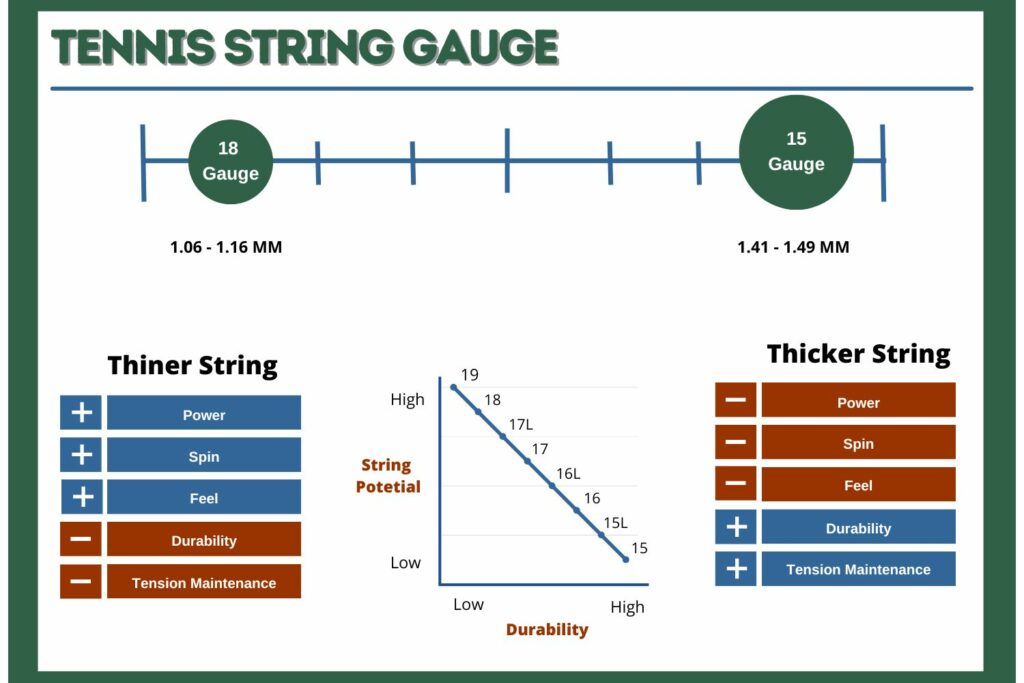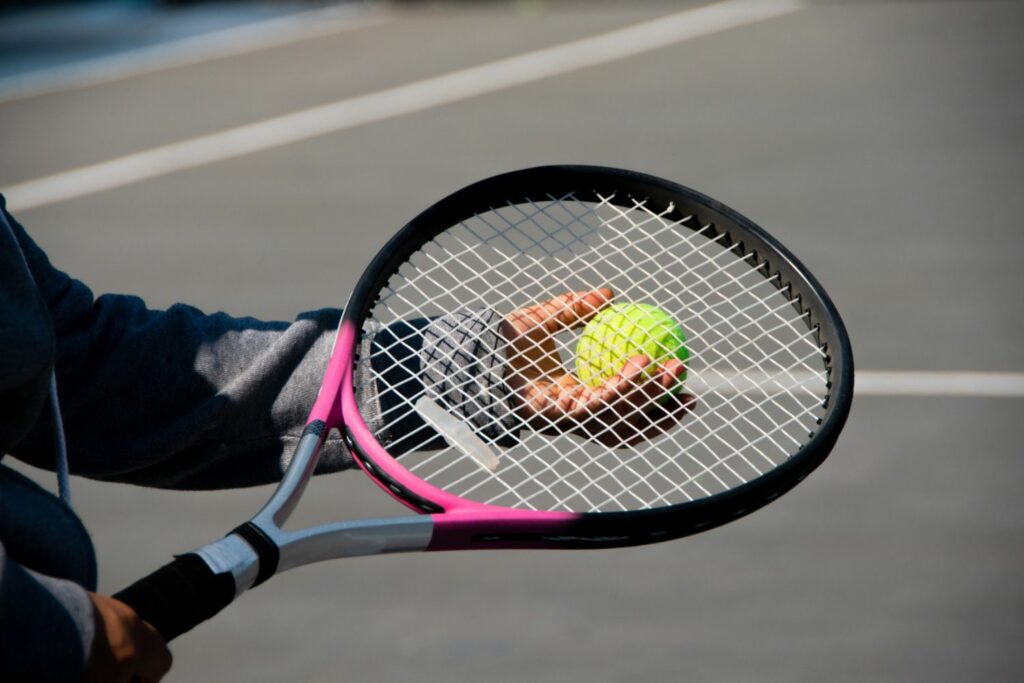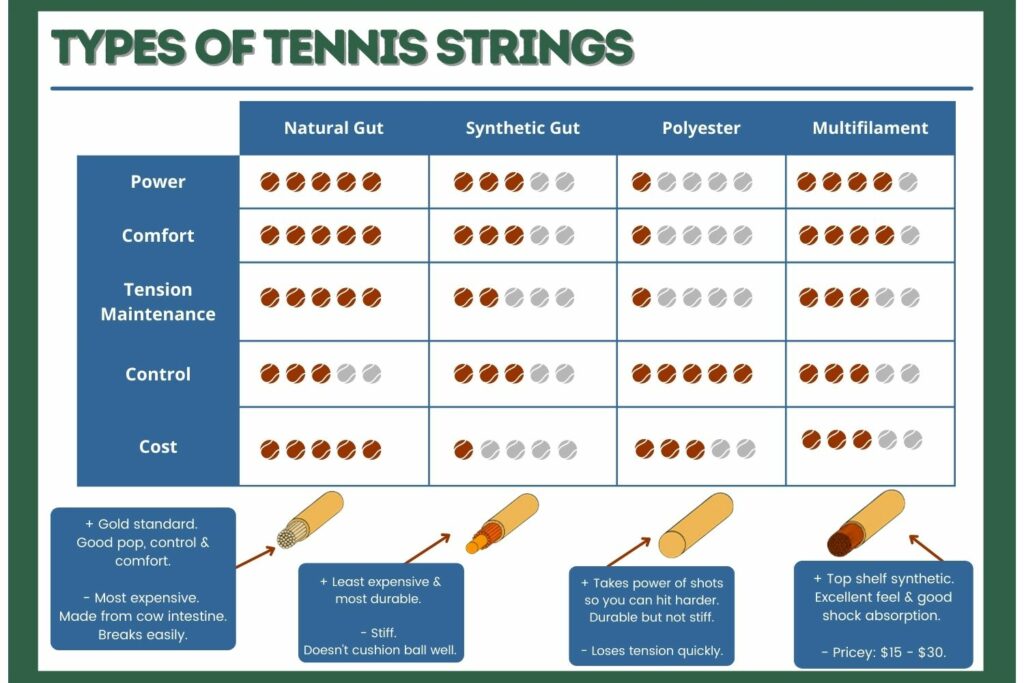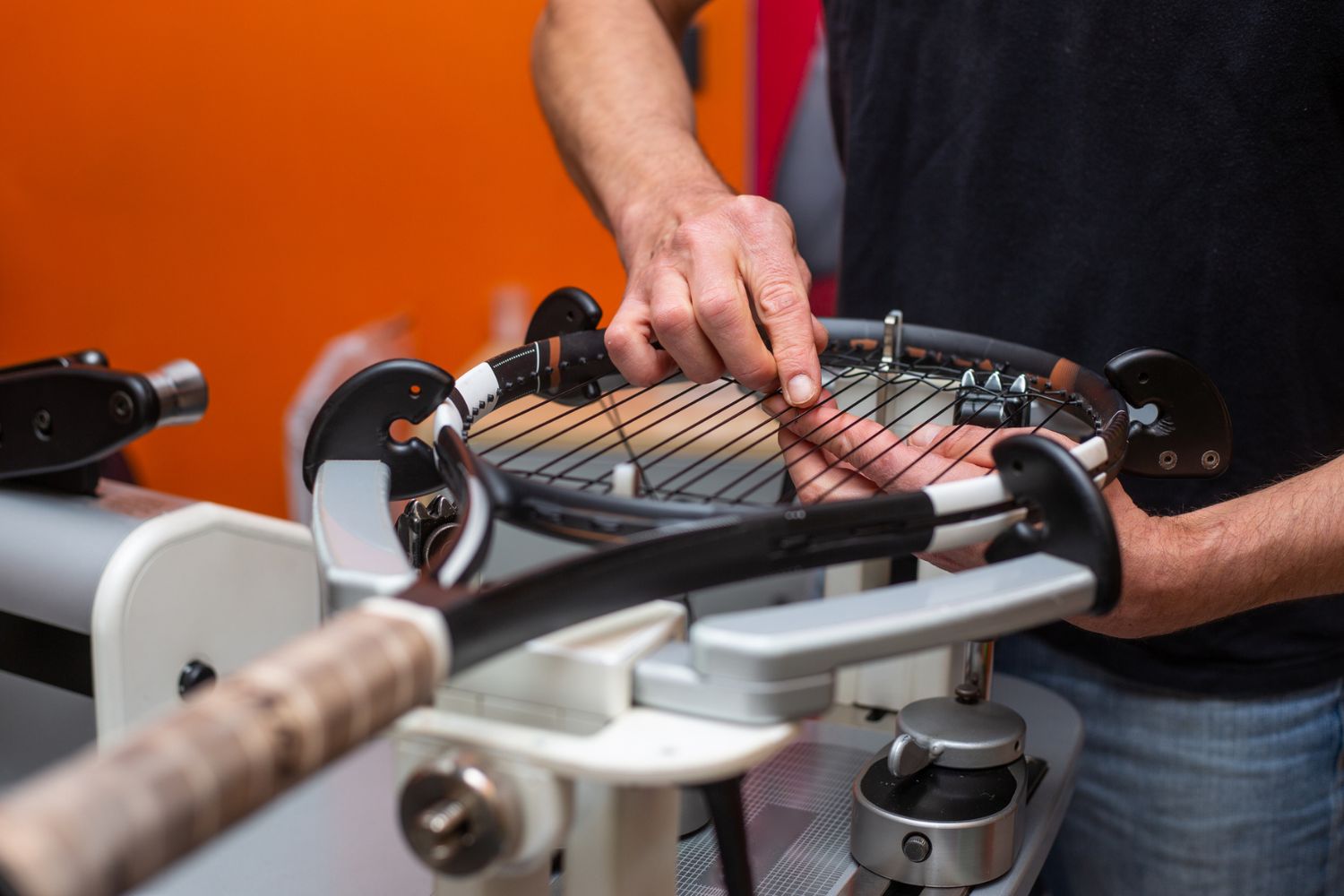- The tennis string gauge refers to the string’s diameter or thickness and usually ranges from 0.6 mm to 1.8 mm.
- The higher the gauge number, the thicker the gauge (except in the US where it’s vice versa).
- There is no one-size-fits-all when it comes to strings, so players should pick a size based on their skill level and what features they prioritize.
- Strings with a thinner gauge offer more spin potential but are less durable, while thicker strings have more durability but muted feel and low spin potential.
When it comes to choosing the right tennis strings, it is important to understand the gauge levels. Many players often overlook this, even though it is a key attribute, and it directly impacts performance. Learning how to determine the right tennis string gauge for you can be very beneficial on the court, as it will help you take full advantage of the features of the strings and have your needs and preferences met.
However, choosing the right gauge levels for the strings can be harder than picking a tennis racket, especially if you are a beginner. The best way to come around it is by educating yourself on the topic, so you’ll be able to tell the difference. Look at our full guide, where we explain everything you need to know about tennis string gauges.
What is Tennis String Gauge?
The tennis string gauge simply refers to the string’s diameter or thickness. Typically the diameter of the string ranges anywhere from 0.6 mm to 1.8 mm, but the manufacturers communicate the gauge rate with a whole number. Most strings fall within 15, 16, 17, and 18 gauge, which are the most popular choices among players.
There is not a fixed tennis string gauge chart, so the ratings are not universal. Usually, the higher the gauge number, the thicker the gauge. While this statement is true for the majority of the world, in the US is all the opposite; the thinner the string, the higher the gauge. Many strings have an added L in the gauge rate, which stands for lighter, signaling thinner, in-between sizes.

Tennis String Gauge Chart
The tennis string gauge chart might not be universal yet; however, most manufacturers commonly accept it and stand by it. Beginner tennis players might find it confusing, so it would be easier to refer to the diameter measurements just to ensure they pick the right gauge.
Most of the packaging often has only the standard labels, so make sure to check on official instructions for the diameter size before making a purchase.
Here is the tennis strings gauge chart;
| Measurements | US Gauge | International Gauge |
| 1.65 – 1.80 mm | 13 | 12 |
| 1.50 -1.65 mm | 14 | 11 |
| 1.41 – 1.49 mm | 15 | 9.5 |
| 1.33 – 1.41 mm | 15 L | 9 |
| 1.26 – 1.34 mm | 16 | 8.5 |
| 1.26 – 1.30 mm | 16 L | 8 |
| 1.16 – 124 mm | 17 | 7.5 |
| 1.06 – 1.16 mm | 18 | 7 |
| 0.90 – 1.06 mm | 19 | 4 |
| 0.80 – 0.90 mm | 20 | 3.5 |
It’s important to highlight that when it comes to strings, there is no one -size- fits- all, which would be an easy solution for all players. However, if you are not sure which gauge rates would be the best choice, you can always stick to a safe range of options, depending on your skill levels and what kind of features you prioritize on the court.
Here are our recommendations to determine what gauge of tennis string is best for you;
- 1.40mm – at this size, the strings are very thick. They offer excellent durability and control; however, this comes in exchange for a more muted feel and less spin potential. Suitable only for advanced players.
- 1.30 mm – thick to medium strings string gauge. You should stick with this size if you are a heavy-hitter player. At this gauge, the strings provide all the right features on the court for easy playability, while you won’t have to worry about them breaking frequently.
- 1.28 mm – medium gauge rate. Strings at this size offer a great blend of control and power, which makes them suitable for competitive players.
- 1.25 mm – medium to thin gauge rate. These strings provide easy power and comfort, making them a great choice for a wide range of skill levels, including beginners and recreational players. You should stick to these gauge rates if you are also recovering from possible injuries.
- 1.20 mm – very thin string size, which is suitable for players that aim for enhanced feeling and don’t mind restringing the frame every now and then.
- 1.15 mm – the thinnest string size. You’ll have an excellent feel at this gauge rate, but it also means that you’ll have to restring often, which can be annoying for most players.
String Gauge and Performance
You won’t be able to fully understand tennis strings gauge meaning without being clear on the way it impacts performance. You should consider three main factors when selecting tennis string thickness; spin potential, durability, and feel.
Spin Potential
Spin is one of the main features most players aim for during their games and practices. Research has shown that the thinner the strings, the more spin you can generate. Thin strings can also offer a better “bite” of the ball, allowing more dwell time and creating a trampoline effect.
Meanwhile, the opposite is true for thicker strings; they don’t “grab” the ball as much and have low spin potential. However, you can not rely only on the thinness of the strings for generating heavy spin because other factors also play a role in this process.
The way how you grip your racket, your techniques, and the racket’s speed all impact spin. After all, strings can only optimize spin potential to improve performance, but it is a must that the player has the skill and experience to generate spin on its own.
Durability
Thicker strings are way more durable than thin ones. This is the golden rule you should follow if you want to prioritize durability. Even if you have minimal experience on the court, you should have noticed by now that strings overlap at the cross-section, which causes fractions.
With time, strings start to notch and will cut each other. This is an inevitable process, but if you pick thick strings, you will successfully delay it. Thicker strings also are more resistant to shock impact, which adds another layer to their longevity.
It’s only normal that tennis players want their strings to last for a long time without needing a replacement; however, you should consider other factors that can influence durability. The material, construction, and how well it can hold tension, or the pattern density plays a big part in how long your strings will last.

Feel
Strings’ different gauges rates can dramatically differ in the kind of feel they deliver. Thinner strings are what players choose when they need to enhance their feel on the court and have a better connection with the racket. Obviously, this comes with a big trade-off on durability, and you should expect your strings to break far more often.
On the other hand, thicker strings have a muted feel and, more often than not, can be harsh on the arm and shoulder. The choice is entirely personal, and in an ideal scenario, you would try different strings gauges before determining what feels best for you.
However, it would be smart if you stick with a middle-range gauge, as these strings offer a good feel while still being moderately durable.
Which String Gauge Should You Use
Picking what gauge tennis string to use on the court shouldn’t be as stressful as long as you are crystal clear about what kind of features you are aiming for. All players, from tennis stars to fresh beginners, have their preferences and personal needs that they should meet. That’s why it’s better to evaluate some crucial factors beforehand.

Type of Strings
Manufacturers use a variety of materials to produce tennis strings. The most popular and common types of string based on their construction are;
- Natural Gut: These strings deliver amazing performance and easy playability. They are loaded with high power potential, are comfortable, and deliver an exceptional feel. Natural gut strings are made of cow membrane’s intestine, which has a softer touch and elastic. However, they are less durable and more prone to break. Natural Gut strings also come at high prices, making them inaccessible for most players, who don’t want to spend a lot of money on something they will have to replace.
- Polyester: These strings deliver amazing control levels and high spin potential. They are pretty cheap and come at very affordable prices, making them a popular option worldwide. On the downside, polyester strings are quite stiff and can lose tension rather quickly.
- Multifilament: These strings can be a great alternative to natural gut. Multifilament tennis strings offer high power levels, are easy on the arm, and can do a great job at holding tension. However, the control levels and spin potential can be disappointing, especially for players that are to play at competitive levels.
- Synthetic Gut: These strings are made primarily of nylon materials. They offer good all-around performance and can provide an excellent learning curve for beginners. However, they tend to lack durability, and their features are only average at best.
- Kevlar: Extremely durable tennis strings, They also can hold tension very well and have a high spin potential. On the downside, these strings aren’t comfortable at all, and the feeling can be very harsh on the arm.
Frequency of Play
How often do you play tennis? If you are a recreational player that hits the courts only once or twice a month, you shouldn’t worry about strings’ durability. In this case, you might as well go for a thinner gauge that offers a great feeling. Over time, the strings will lose tension and start breaking, so you will be replacing them only semi-regularly.
On the other hand, if you are a regular on the tennis court and constant with your training session is wiser to lower the gauge rate. This way, you’ll increase the durability of your strings and won’t have to restring or replace them every now and then.
Skill Level
You’ll be able to make the right gauge choice if you can objectively evaluate your skill levels on the court. It’s much easier this way, as you’ll be clearer about what to look for when picking tennis strings. For example, synthetic gut in a thicker gauge rate can provide the best learning experience if you are a beginner. At this stage, it’s unlikely to notice any true difference between gauges, so it’s better to choose long-lasting strings that won’t break easily.
For intermediate and advanced levels, there is no clear answer on what gauge is the best for you. It’s better to experiment a little, and only after that make a decision on what you prefer the most, and it helps you perform better.
Game Style
Once players are past intermediate levels, they start developing a distinctive game style and strategy. It takes skills and experience, and at this stage, these players know what kind of strings to choose.
Aggressive baseliners usually go for options that can provide high spin, and control, while all courters chose hybrid settings to try and emulate a variety of features. The key word here is to experiment as much as possible before settling for a specific brand and series.
Hybrid Stringing
Many advanced players choose to combine two different kinds of strings; one for the vertical mains and the other for the horizontal crosses. This practice is known as hybrid stringing and aims to strike a balance between various features, which allows players to optimize their string potential on the court.
Usually, both strings are chosen at the same gauge, but there are players out there, like Federer, that uses hybrid stringing at different thickness rate.
Comfortability Levels
When it comes to finding what gauge strings are comfortable for you, the keyword is, again, experiment. The studies till now have not given a clear answer on what would the optimal gauge rate for maximum comfort. So try out different rates until you find that sweet spot where strings are easy on the arm while still delivering performance and a variety of features.
Gauge Recommendation for Beginners
When you are just starting out in tennis, the task of finding the right gauge might seem difficult and overwhelming.
Our best tip is to start with a 16 gauge string, which is the perfect middle ground. At this rate, you’ll have a variety of features, including power, durability, and comfort.
Many brands offer a wide selection of strings that are specifically this thick, which also come at affordable prices. As you progress, you’ll be able to experiment with other gauge levels too, which will help you learn the differences in feel and performance.
Tennis String Gauge 16 vs. 17
16 gauge strings have a diameter that can vary between 1.26 – 1.34 mm, while 17 gauge ranges anywhere from 1.16 – 124 mm. By simply looking at the differences in the thickness rate, it’s easy to tell that 16 gauge is a more durable option, while 17 gauge offers an enhanced feeling.
Tennis String Gauge 17 vs. 18
The tennis strings with a 17 gauge level have a perimeter that varies between 1.16 – 124 mm. At this level, the strings rate as medium to thick. They can provide a lot of power, high comfort, and overall good performance.
On the other hand, 18 gauge provides excellent feel and control over the ball. This is the thinnest rate possible which is also prone to breakage and requires continuous restraining on the frame.
What Tennis String Gauge the Pros Use
The easiest, fastest way to look like a famous star player is by using the same strings. Using the same gauge as your favorite can be a good starting point of reference, while you can still experiment with other options until you find the ones that are just right.
However, you should only go for it only if your budget stretches enough to cover costs while also being able to experiment.
Here is what gauges tennis professionals use:
| Player | Mains | Crosses |
| Rafael Nadal | Babolat RPM Blast 15L | Babolat RPM Blast 15L |
| Serena Williams | Wilson Natural Gut 16 | Luxilon 4G 16L |
| Roger Federer | Babolat VS 16 | Luxilon ALU Power 16L |
| Novak Djakovic | Babolat VS 16 | Luxilon ALU Power 16L |
| Naomi Osaka | Yonex Poly Tour Strike 16L | Yonex Poly Tour Strike 16L |
| Karolina Pliskova | Babolat VS 16 | Babolat Pro Hurricane 17 |
FAQs
The right tennis string gauge for your tennis racket is a factor that makes you dominate and win the game. With so many sizes and differences choosing a tennis string gauge can be overwhelming. The right pick will deliver victories in every game you play. Read on for some frequently asked questions and answers about tennis string gauge.
Q: What gauge of tennis racket string is good for spin?
A good gauge for tennis racket string for spin would be around 16 or 17. The higher the number, the thinner the string will be. A thin string provides more opportunity for the ball to grip the strings and create more spin. Thicker strings tend to create less spin.
Q: What gauge of tennis racket string is good for power?
A good gauge of tennis racket string for power would be around 18 or 17. This is because a thicker string will provide more power but will also be less responsive and harder to control. Whereas a thinner string will offer more responsiveness and control but less power.
Q: What is the most commonly used string gauge in professional tennis?
Most professional tennis rackets are strung with a gauge of 16-18. This is because this range gives the best combination of power, control and feel. A gauge of 16 is firmer and will provide more power, while a gauge of 18 is more flexible and will provide more control and feel.
Q: Can string gauge impact durability of the strings?
Yes, string gauge can impact durability. Thinner strings (higher gauge numbers) tend to break more easily and may need to be restrung more often. Thicker strings (lower gauge numbers) will typically last longer before needing to be restrung.

